If you work with data, counting unique values is a must because clean data produces better insights. In this guide, I’ll show you how to count unique values in Excel. I'll also show you special cases, such as how to handle case-sensitivity, or how to count unique values based on one or more conditions.
Because the ideas sometimes get confused, I'll take some time to disabuse you of any misunderstanding you might have about the difference between unique and distinct values in Excel and, in case you were looking to perform a distinct count instead, I'll show you how at the end of this article.
As a last thing before we get started, I want to point out that these are just some of the types of things covered in our Excel Fundamentals skill track, so enroll today to become an expert.
A Note on Unique Values vs. Distinct Values in Excel
Sometimes, the terms unique values and distinct values are used interchangeably, but they are not the same thing. So, here’s a quick comparison to help you understand their difference.
Distinct values are the different values in a dataset, with duplicates removed. For example, in the list A, A, B, C, C, D, the distinct values are A, B, C, D.
Unique Values, on the other hand, are values that occur only once in the dataset. Using the same example, the unique values are B and D (because A and C appear more than once).
For the first half of the article, I will focus on different ways to count unique values in Excel. But, if you have landed here by accident and are really looking to count distinct values, I have you covered for this, also, if you want to scroll to the later section.
Methods to Count Unique Values in Excel
There are two common ways to count unique values in Excel.
Method 1: Use the UNIQUE() function with the correct parameter
The easiest way to count unique values is by using the UNIQUE() function and the COUNTA() function. The UNIQUE() function extracts all unique values from a range, and COUNTA() counts how many unique values are present.
COUNTA(UNIQUE(range, false, true))For example, I applied the following formula to a small dataset, and it gave me unique values.
=COUNTA(UNIQUE(A2:A8, false, true))
Count unique values using UNIQUE() and COUNTA() function. Image by Author.
If you used this syntax instead, =COUNTA(UNIQUE(A2:A8)), which doesn't have the third parameter that we set as TRUE, then we would get back as our result a distinct count, not a unique one. Setting TRUE in the third argument tells the function to return a unique count. Both things are within the UNIQUE() function, so it may be a bit confusing at first.
Method 2: Use SUM() with IF() and COUNTIF()
If you are a little unsure of the nuances of the UNIQUE() function, or if you don't have Excel 365, know that we can also combine SUM() with IF() and COUNTIF() to count the unique values.
=SUM(IF(COUNTIF(range, range)=1,1,0))For example, I have data in the range A2:A8 and want to count the unique values, so I write the following formula:
SUM(IF(COUNTIF(A2:A8, A2:A8)=1,1,0))Here COUNTIF() goes through the list and checks how many times each name appears. If a name shows up just once, it counts it as 1. If it appears more than once, it gets a higher number. Then, IF() filters those results to keep the 1s as they are but turns everything else into 0. At last, SUM() adds up all the 1s and gives us the total count of unique values.
Count unique values using SUM(), IF(), and COUNTIF(). Image by Author.
Counting Unique Text and Numeric Values
Sometimes, our dataset contains mixed data types and we have to analyze them independently. This may look a bit daunting at first, but it’s possible in Excel. Let’s look at two methods — one for counting unique text values and another for unique numbers.
Count unique text values
If you want to count unique text values, combine the ISTEXT(), COUNTIF(), and SUM() functions. ISTEXT() checks if a value is a text, while COUNTIF() counts how many times each value appears, and SUM() totals the distinct text entries.
I applied the following formula on a sample data, and it instantly showed me how many unique text values are present.
=SUM(IF(ISTEXT(A2:A9)*COUNTIF(A2:A9,A2:A9)=1,1,0))
Count unique text values. Image by Author.
Count unique numeric values
If you want to count unique numbers instead of text, use the same formula but replace the ISTEXT() with ISNUMBER(). ISNUMBER() will only consider numeric values, while COUNTIF() and SUM() handle the uniqueness. I tweaked the above formula on the same data, and it now shows me the number of unique numeric values only:
=SUM(IF(ISNUMBER(A2:A9)*COUNTIF(A2:A9,A2:A9)=1,1,0))
Count unique numeric values. Image by Author.
Counting Unique Values with Conditions and Criteria
Now that we’ve covered the basic methods for counting unique values, let’s explore some advanced techniques.
Count unique values based on conditions
To count the unique values based on a specific condition, I use this syntax:
=IFERROR(ROWS(UNIQUE(FILTER(range, criteria_range=criteria))), 0)In this formula, FILTER() filters out the range based on specific criteria, UNIQUE() removes duplicates, ROWS() counts the results, and IFERROR() prevents errors by returning Not Found if no matches are found.
Let’s say I have a list of Employees and their Departments, and I need to count how many unique employees work in a specific department. I will use the following formula:
=IFERROR(ROWS(UNIQUE(FILTER(A2:A20, B2:B20=F1))), "Not Found")Here, A2:A10 represents the range of employee names I want to filter and B2:B10=F1 checks which employees belong to the department, which is written in F1.
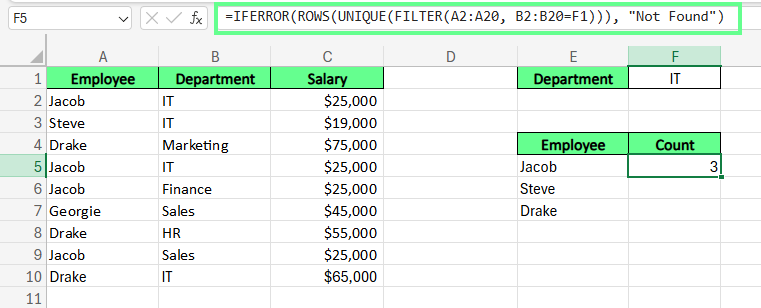
Count unique values with a condition. Image by Author.
Count unique rows based on multiple columns
If I want to count unique employees in a specific department whose salaries are less than $50,000, I use this formula:
=IFERROR(ROWS(UNIQUE(FILTER(A2:A10, (B2:B10=F1) * (C2:C10>F2)))), "Not Found")Here, A2:A10 represents the range of employee names, B2:B10=F1 checks which employees belong to the department written in F1, and C2:C10>F2 checks if the salary is less than the amount given in F2.
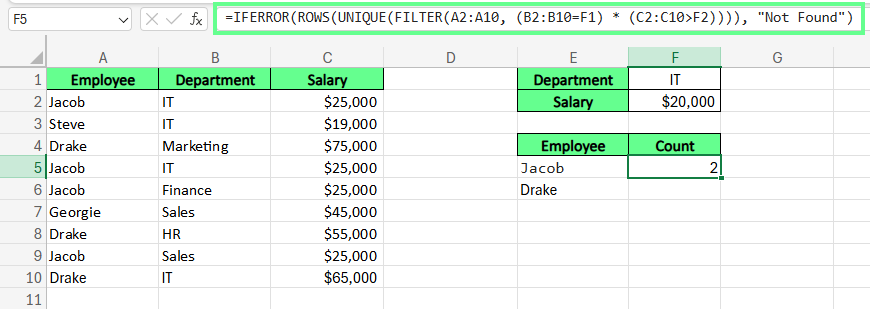
Count unique values with multiple criteria. Image by Author.
Case-sensitive unique counts
By default, Excel is case-sensitive. For example, Apple and APPLE are considered different. To spot such cases, I create a helper column with the following formula:
=IF(SUM((--EXACT($A$2:$A$11,A2)))=1,"Unique","Duplicate")And now, to get the count of unique values, I use the COUNTIF() function like this:
=COUNTIF(B2:B11,"Unique")
Count case-sensitive unique values. Image by Author.
Best Practices for Counting Unique Values in Excel
Here are a few of my favorite practices that will help you keep things accurate and efficient:
- Make sure there are no extra spaces or inconsistent formatting in the data. Otherwise, it will throw an error.
- Your data range should not include empty cells, as they can mess up the result.
- If your data changes often, use PivotTables or dynamic array functions to keep everything updated in real-time.
How to Count Distinct Values Instead
Now, as a final section, in case you had really wanted to count distinct values instead, I will show you several methods to count distinct values.
Method 1: Use the COUNTIF() and SUM() functions
To count distinct values in Excel, you can combine the COUNTIF() and SUM() functions. The COUNTIF() function checks how many times each value appears in a given range. Then, SUM() adds up the values returned by COUNTIF(), giving the total number of distinct entries.
=SUM(1/COUNTIF(range, range))Let’s say I want to find the distinct values in the range A2:A8. I enter the following formula:
=SUM(1/COUNTIF(A2:A8, A2:A8))Here, the COUNTIF() function checks how many times each value appears in a list.
1/COUNTIF(A2:A8, A2:A8) divides 1 by the number of times each value appears. For example, if a number appears twice, each instance becomes 0.5 (1/2). If it appears three times, it will be 0.33 (1/3).
Since we don’t want these fractions, we can use the SUM() or SUMPRODUCT() to add up all the values. Every duplicate’s fractions combine to 1, and distinct values stay 1 since 1/1 = 1:
=SUMPRODUCT(1/COUNTIF(A2:A8, A2:A8))
Count distinct values using COUNTIF() and SUM() functions. Image by Author.
Method 2: Use PivotTables for distinct counts
Excel 2013 and Excel 2016 have included a built-in feature to count distinct values in a PivotTable. To make use of this, you first have to create a PivotTable by selecting data: Go to Insert and select PivotTable. A dialog box will appear — from this dialog box, choose Existing Worksheet and checkmark the Add this data to the Data Model box.
Create a PivotTable. Image by Author.
Next, drag your desired column into the Values field. In my case, I drag the Fruits column because I want to count its distinct values. Then, click on Value Field Settings from the drop-down menu. A pop-up will appear — from there, select Distinct Count. You can even give this column a custom name, but that's optional.
Count distinct values using PivotTable. Image by Author.
Method 3: Apply advanced filters
If you don't like working with formulas, use the advanced filters instead.
In this example, I have a dataset and I want to find distinct values using advanced filters. Now, for this, I select the range from where I want to find the particular value. Then, I go to the Data tab and click Advanced.
Now, in the Advanced Filter dialog box, I choose Copy to another location, and in the Copy to field, I enter the destination cell where I want my list to appear. Then check the Unique Records Only box and click OK.
Once I have a list of unique values, I then calculate the count of these unique values by using the ROWS() function:
=ROWS(D2:D5)Even though the option in the below image reads Unique records only, it actually extracts distinct values.

Count distinct values using an Advanced Filter option. Image by Author.
Method 4: Implement VBA macros
If you want to count distinct values repeatedly, use VBA (Visual Basic for Applications), where we write code once, and it automates the whole process every time we call the function with its name.
Here’s how you can use this: press Alt + F11 and go to the Module option under the Insert tab. A new module will appear, and you can paste your code here.
This is the code I created to count the distinct values:
Function CountUnique(rng As Range) As Integer
Dim dict As Object
Set dict = CreateObject("Scripting.Dictionary")
Dim cell As Range
For Each cell In rng
If Not dict.exists(cell.Value) And cell.Value <> ""
Then,
dict.Add cell.Value, Nothing
End If
Next cell
CountUnique = dict.Count
End Function
Write a code in the VBA editor to find distinct values. Image by Author.
Then, press Ctrl + S to save it and ALt + Q to close the VBA editor. Now, you can call this custom function anywhere in the sheet and specify the range from which to find the distinct values. In my case, it's called CountUnique() so every time I call this function with a specified range, it gives me a count value:
=CountUnique(A2:A8)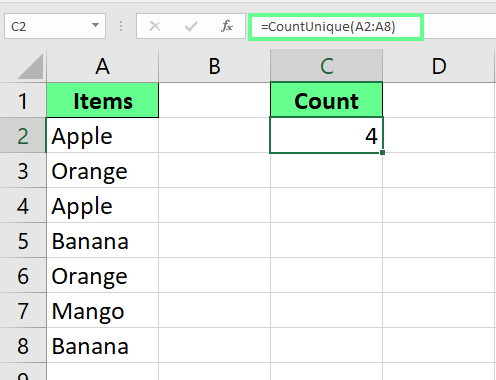
Count distinct values using the VBA editor. Image by Author.
Reference table
For reference, I've created a table to help you keep straight the differences between unique and distinct counts.
| Criteria | Unique Values | Distinct Values |
|---|---|---|
| Definition | Values that appear only once in a dataset. | All different values in a dataset, including one occurrence of each duplicate. |
| Duplicates included? | No, duplicates are excluded. | Yes, but only one instance of each value is kept. |
| Example | In [1, 2, 2, 3, 4], unique values are [1, 3, 4]. |
In [1, 2, 2, 3, 4], distinct values are [1, 2, 3, 4]. |
| Use case | Finds values that occur only once. | Gets a list of all distinct values. |
Common Issues and Troubleshooting
Sometimes, even after following best practices, you may face challenges. But it’s okay because this happens with most people.
Sometimes, I get an error and feel confused, only to realize that the hidden spaces are the problem. This happens when some values have extra spaces at the beginning or end and Excel treats such cases differently, even if they look the same. To fix this, I wrap my formula inside the TRIM() function. Read my other tutorial, Use the TRIM() Function in Excel: Fix Any Spacing Issue if you have any lingering questions about TRIM().
Another common issue is formula errors in older Excel versions. For example, UNIQUE() doesn’t work in Excel 2016 or its previous versions. Instead of this, use COUNTIF() or SUMPRODUCT().
Final Thoughts
I’ve covered key formulas, PivotTables, and VBA macros for counting unique and distinct values. Each method has its benefits, but you should choose the one that suits your needs and supports your Excel version.
If you want to sharpen your Excel skills, check out our Excel Fundamentals skill track and Data Preparation in Excel course.
Advance Your Career with Excel
Gain the skills to maximize Excel—no experience required.
I'm a content strategist who loves simplifying complex topics. I’ve helped companies like Splunk, Hackernoon, and Tiiny Host create engaging and informative content for their audiences.
FAQs
How do I count unique values without counting blanks?
You can use this formula:
(UNIQUE(FILTER(range, range<>"")))Here’s how it works:
FILTER()filters the empty cells.UNIQUE()removes duplicates.COUNTA()counts the unique non-blank values.
How do I highlight unique values using Conditional Formatting?
Select the range of data and go to the Home tab > Conditional Formatting > Highlight Cells Rules > Duplicate Values. Choose Unique from the dropdown menu in the pop-up window and click OK.
Can I extract unique values using the Remove Duplicates option in Excel?
Yes, you can use the Remove Duplicates option to extract unique values. To do so:
- Select the range, go to the Data tab, and click Remove Duplicates.
- In the pop-up window, check the columns where you want to find duplicates.
- Click OK, and Excel will remove duplicate values, keeping only unique ones.

